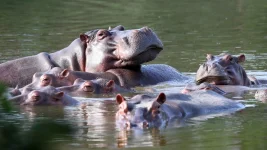Anthrax has killed at least 50 hippos plus other large animals in Virunga National Park. Park officials found these dead creatures floating down a main river that runs into one of Africa's biggest lakes. Emmanuel De Merode, who runs the park, said tests proved anthrax caused these deaths, affecting buffalo as well. Nobody knows exactly where the poison came from. The park shared pictures showing hippos lying dead on their sides or backs in the Ishasha River, some stuck in muddy areas along the banks.
This hits the park hard because they worked for years to increase hippo numbers. Hunting and fighting had cut the population from over 20,000 to just a few hundred by 2006. Today, about 1,200 hippos live there. Park guards first noticed something wrong about five days ago when dead animals started appearing in the river. This section of the river marks the border between Congo and Uganda, running through an area where rebel fighters control the land.
Anthrax is a bacteria that lives naturally in soil. Wild animals catch it when they breathe in spores from dirty soil, plants, or water. The Congolese Institute for Nature Conservation warned people living nearby to stay away from wildlife and to boil water before drinking it. Park director De Merode said his team tries to remove the hippos from the water and bury them deep, but they lack proper equipment like excavators.
He explained how hard this task has become because they cannot easily reach the area or move the heavy animals. They want to bury the bodies with caustic soda to stop the disease from spreading further. The river flows north into Lake Edward, where local people have seen even more dead hippos. Thomas Kambale, a community leader in Nyakakoma, counted more than 25 hippo bodies floating near his village, from Kagezi all the way to Nyakakoma.
Virunga spreads across a huge area filled with deep forests, glaciers, and volcanos. It contains more species of birds, reptiles, and mammals than any protected area worldwide. The park has suffered through years of militia fighting since civil wars broke out around twenty years ago. These armed groups make conservation efforts much harder, as park rangers cannot safely access all areas under their care.
This hits the park hard because they worked for years to increase hippo numbers. Hunting and fighting had cut the population from over 20,000 to just a few hundred by 2006. Today, about 1,200 hippos live there. Park guards first noticed something wrong about five days ago when dead animals started appearing in the river. This section of the river marks the border between Congo and Uganda, running through an area where rebel fighters control the land.
Anthrax is a bacteria that lives naturally in soil. Wild animals catch it when they breathe in spores from dirty soil, plants, or water. The Congolese Institute for Nature Conservation warned people living nearby to stay away from wildlife and to boil water before drinking it. Park director De Merode said his team tries to remove the hippos from the water and bury them deep, but they lack proper equipment like excavators.
He explained how hard this task has become because they cannot easily reach the area or move the heavy animals. They want to bury the bodies with caustic soda to stop the disease from spreading further. The river flows north into Lake Edward, where local people have seen even more dead hippos. Thomas Kambale, a community leader in Nyakakoma, counted more than 25 hippo bodies floating near his village, from Kagezi all the way to Nyakakoma.
Virunga spreads across a huge area filled with deep forests, glaciers, and volcanos. It contains more species of birds, reptiles, and mammals than any protected area worldwide. The park has suffered through years of militia fighting since civil wars broke out around twenty years ago. These armed groups make conservation efforts much harder, as park rangers cannot safely access all areas under their care.












